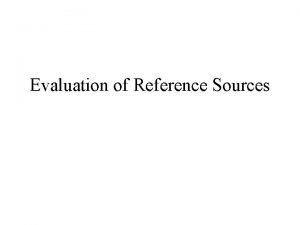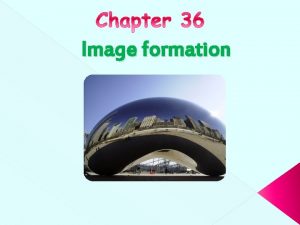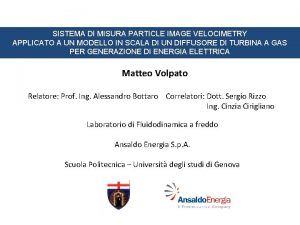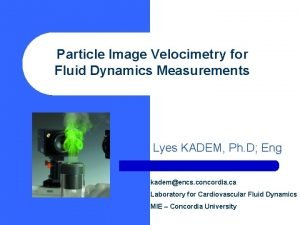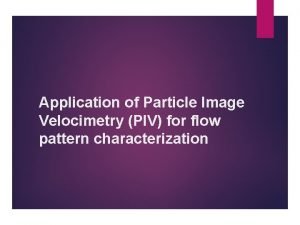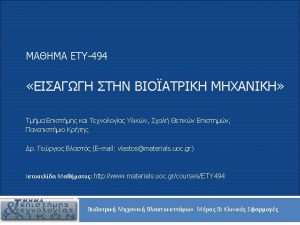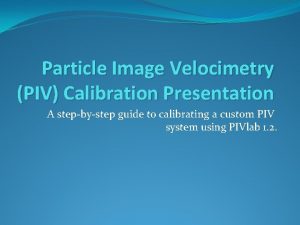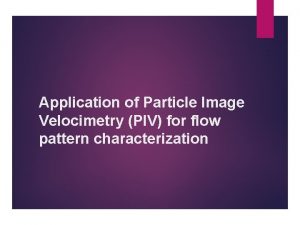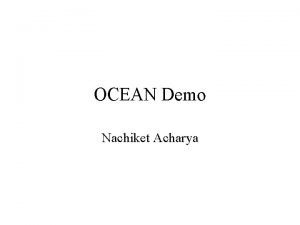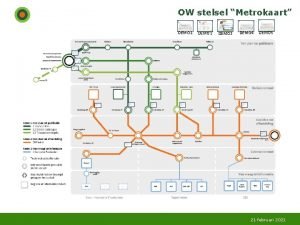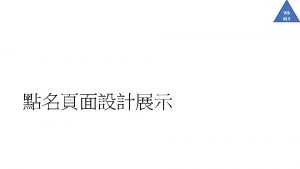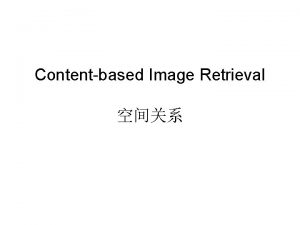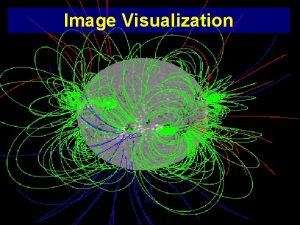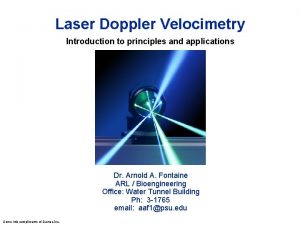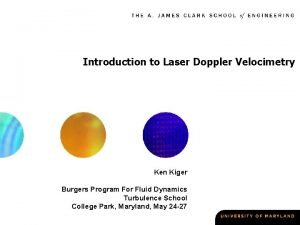Particle Image Velocimetry Demo Outline For reference Particle



















- Slides: 19

Particle Image Velocimetry Demo Outline (For reference)

Particle Image. Velocimetry Particle Image The Particle Imaging Velocimetry (PIV) is a quantitative velocity measurement technique, with visualizing the flow field by small tracer particles and with analyzing the visualized digital images. In this topic discusses about Direction of fluid flow, direction of light travel and randomly selected image patterns.

Particle Image Velocimetry Flow of Particle Image Velocimetry START Laser • Lasers are predominant due to their ability to produce high-power light beams with short pulse durations. • This yields short exposure times for each frame. Click START.

Particle Image Velocimetry Flow of Particle Image Velocimetry START Optical Equipment • • The optics consist of a spherical lens and cylindrical lens combination. The cylindrical lens expands the laser into a plane while the spherical lens compresses the plane into a thin sheet. Click START.

Particle Image Velocimetry Flow of Particle Image Velocimetry START Seeding • • The seeding particles are an inherently critical and reflective component of the PIV system. So that the laser sheet incident on the fluid flow will reflect off of the particles and be scattered towards the camera. Click START.

Particle Image Velocimetry Flow of Particle Image Velocimetry START Camera • To perform PIV analysis on the flow, two exposures of laser light are required upon the camera from the flow. Click START.

Particle Image Velocimetry PIV overview

Particle Image Velocimetry To compute particle displacements, the image plane is divided into several small disjoint or overlapping interrogation windows and corresponding window pairs in consecutive recordings are cross correlated. The spatial displacements that produces the maximum cross-correlation statistically approximates the average displacement of the particle in interrogation region. This displacement divided by the time between the lazer pulses, yields the velocity that is associated with each interrogation area. The cross corelation function for two discretely sampled interrogation windows is defined by :

Particle Image Velocimetry With f i, j and g i, j indicating image density distribution of the first and second image M and n are pixel offset distances between the two images. C f, g(m, n) is the Two dimensional cross corelation function. Given the size of the interrogation area is M, then O(M 4) operations have to be computed. The cross corelation between the two image pairs are normalized to prevent false correlation peaks arising from changes in the search area local means. To remove additive local bias differences and other noises the mean is removed from both interrogation windows and each correlation sample is divided by

Particle Image Velocimetry Where μF and μG are the means of the first and second interrogation windows. The wienier khinchin thoerm states that cross corelation between f*g between the two signals can be computed in the frequency domain as Where Ff, and F*g are fourier transform of first interrogation window and complex conjugate of fourier transform of second interrogation window. F-1 represent inverse fourier transform. The overall complexity of the system now reduces to O[M 2 ln(M)] operations.

Particle Image Velocimetry Cross correlation of Images • In signal processing, cross-correlation is a measure of similarity of two waveforms as a function of a time-lag applied to one of them. • This is also known as a sliding dot product or inner-product. Click the Quiz button

Particle Image Velocimetry

Particle Image Velocimetry Errors in PIV • Random Errors : Wich occur due to noise in the recoreded images • Bias errors: Arising from the process of computing signal peak location to sub pixel accuracy. • Gradient Error: arising due to rotation and deformation of flow within an interrogation spot leading to loss of correlation. • Tracking errors : Arising due to Inability of the particle to follow the flowwithout slip. • Accelerating Errors: occuring caused due to approximating the local eulerian velocity from the lagrangian motion of the tracer particles

Particle Image. Velocimetry Particle Image Which of these is/are used as seeding material ? • Glass particles • PVC • Mica • Fluid itself

Particle Image. Velocimetry Particle Image • The PIV technique provides ____ ? • Measurement of average velocity with high accuracy • Measurement of Instantaneous velocity with high accuracy • Measurement of instantaneous velocity with low accuracy. • Measurement of overall velocity with low accuracy.

Particle Image. Velocimetry Particle Image • The order of time difference between two image snaps by the CCD Camera is? • 1 second • 1 millisecond • 1 Microsecond • 1 nanosecond

Particle Image. Velocimetry Particle Image • Which controls time between first Image & Second image? • Laser • Synchronizer • Seeding material • all

Particle Image Velocimetry The velocity of fluid can be measured accurately by ----? o o Flow meter o Venturimeter o Prandtl pitot tube o Particle Image velocimetry

Particle Image Velocimetry http: //www. dantecdynamics. com/default. aspx? ID=6 51 http: //www. dantecdynamics. com/Default. aspx? ID=1 049 http: //www. piv. de/piv/index. php http: //research. me. udel. edu/~prasad/papers/curr_s ci_2000. pdf
 Reference node and non reference node
Reference node and non reference node Reference node and non reference node
Reference node and non reference node How to make a sandwich paragraph
How to make a sandwich paragraph Criteria for evaluation of reference sources
Criteria for evaluation of reference sources Image formation outline
Image formation outline Kontinuitetshantering i praktiken
Kontinuitetshantering i praktiken Typiska drag för en novell
Typiska drag för en novell Tack för att ni lyssnade bild
Tack för att ni lyssnade bild Ekologiskt fotavtryck
Ekologiskt fotavtryck Varför kallas perioden 1918-1939 för mellankrigstiden?
Varför kallas perioden 1918-1939 för mellankrigstiden? En lathund för arbete med kontinuitetshantering
En lathund för arbete med kontinuitetshantering Adressändring ideell förening
Adressändring ideell förening Personlig tidbok för yrkesförare
Personlig tidbok för yrkesförare A gastrica
A gastrica Vad är densitet
Vad är densitet Datorkunskap för nybörjare
Datorkunskap för nybörjare Tack för att ni lyssnade bild
Tack för att ni lyssnade bild Debatt artikel mall
Debatt artikel mall Autokratiskt ledarskap
Autokratiskt ledarskap Nyckelkompetenser för livslångt lärande
Nyckelkompetenser för livslångt lärande



